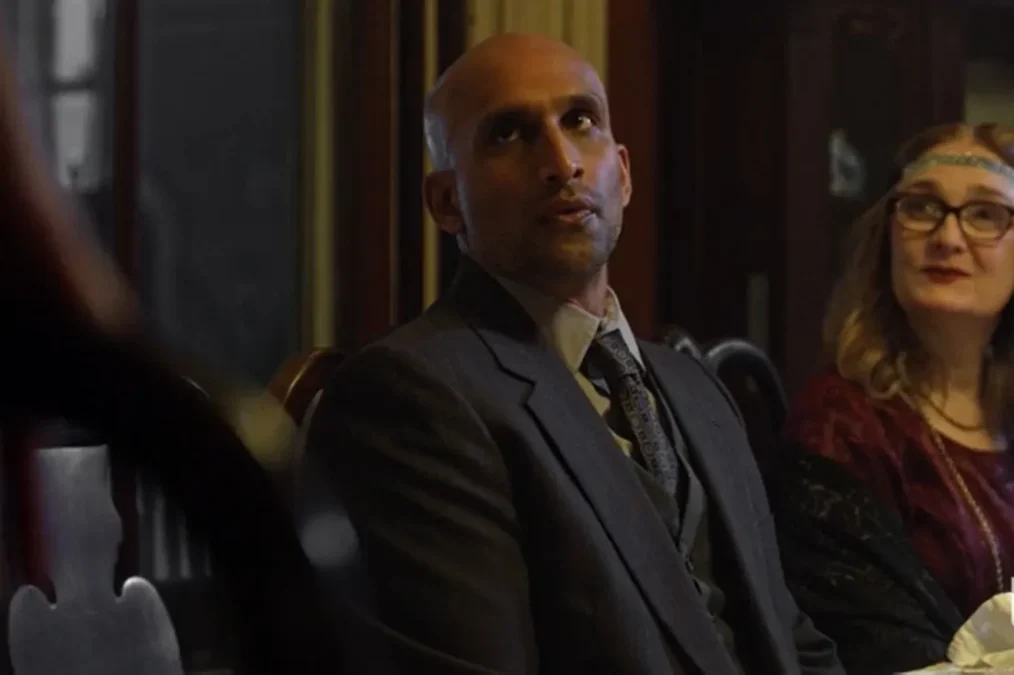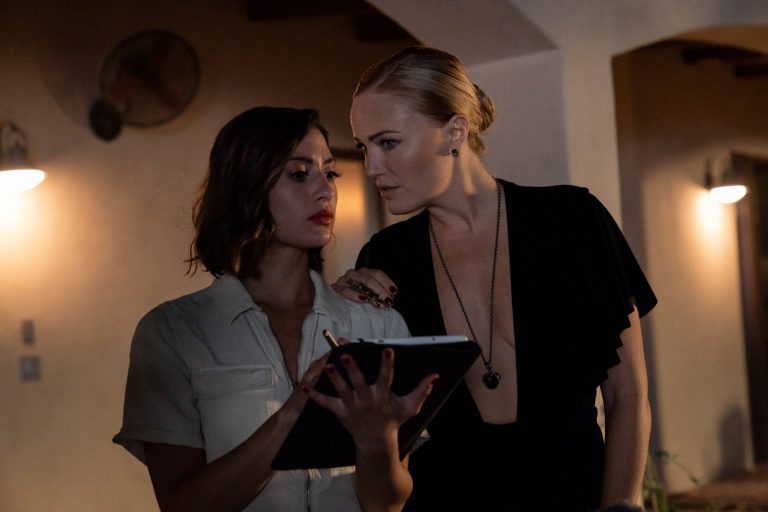David Benullo’s “Murder At Blackthorne Manor” (2025) belongs to the instantly disposable crop of lazy, tacky Lifetime movies that demand no laboured thought or particular, invested patience. It’s a quick fix that rewards no intelligence or care in bringing additional efforts.
The film is as silly as extraneous. It’s a shame because the chamber drama with an ensemble of potential suspects against a murder backdrop could have been entertaining. That is surely not the case because Suzanne Egan’s screenplay is merely content piggybacking on sagging, old tropes and lacks bite. Tension doesn’t even exist before I can accuse the film of diffusing it by its end.
The film struggles to distinguish itself from a mere, bland appellation of scenes sans intrigue and depth. There’s no dimension of danger or a spike in the proceedings. It’s not to say the makers don’t attempt to throw in twists and revelations.
But the problem is a strict, jaded adherence to the script, cutting out any scope for innovation and spark. Individual characters don’t get to stand out or even establish themselves before I can situate inter-personal tensions. There’s too much isolation, which doesn’t breed much chemistry. The little there is becomes a red herring.
Murder At Blackthorne Manor (2025) Plot Summary & Movie Synopsis:
Am I supposed to cheer and exult at the surprises and their reveals? Why is the film so worn out? It’s hard to be in the boat with a thriller whose suspense and trepidation bleed out so quickly. Sustaining a strong, committed, abiding pace is anyway a tall ask, which the film expectedly bungles.
Motivations are kept too foggy and explained in a big gush at the very end. It’s a bit of a cheat because one only comes to know of crucial things too late before they can form their intuitions. Even a pulpy thriller calls for active participation, a whizzing of the brain, enabling the viewer to chip along and be a considerable member of the fun and games. Instead, this film holds its cards for much too long, rather unforgivably. The accretion of suspense checks out early.
The film opens in the titular manor, which the hostess Hayley (Christie Leverette) introduces as once being the hotbed of illicit amorous crimes. She presides over a game of murder mystery that’s staged at the manor. Guests are invited to figure out the killer before they get away, or, worse, strike again.
Hayley’s boss and the manor’s owner, Charles, reposes great trust in her. He lavishes praise on her for holding the fort, keeping business steady. She’s glad that she is doing her job well, but feels uneasy with the laudations. Hayley is grateful that she still has a job. She’s been doing this for a while.

The film initiates the plot via one of the orchestrations of a murder. A group of guests has assembled at the manor. Hayley takes them through the rules of the game, acquaints them with the lay of the land. There’s enthusiasm and excitement, not really any apprehension because it’s all make-believe, a plaything for a weekend of indulgence and entertainment.
But the stakes suddenly rise when an actual murder takes place. Hayley and a co-staffer, Jackson (Bobby Slaski), have a soft spot for each other and are leaning into an intimate moment when they are startled by a loud sound. They scramble into Charlie’s office and find him killed. Horrified, Hayley is at her wits’ end. This is her worst nightmare coming true, which she had never imagined possible. The game has turned real. Thus begins a night of suspicion and trying to protect oneself from the lurking killer.
Hayley and Jackson discover the phones are missing from the safe, telephone lines are snipped, and the front gate is locked. They are trapped in the estate. So the group has to contend among themselves. But the film doesn’t quite give any distinct identities. One gets the veil of secrecy intended to make the puzzle work, but the obfuscation doesn’t go to cheeky extremes.
I watched it mostly passively. There’s Diana, who reveals herself as the manor’s angel investor in the mystery games. Hayley insists that all the other guests lock up for safety. But chaos soon erupts. Hayley barely survives an attack. She discovers in Charlie’s office a scrap of a legal deed. She finds the rest of it in the heath. One of the guests is found dead. It’s Gordon, who was in real estate. Hayley also discovers that all the doors have been unlocked. The keys have vanished. Yet she urges all to stay put, inside their rooms.
Hayley, Jackson, and Diana come across Roy, the handyman of the manor, who had been fired earlier in the morning by Charlie. He reveals he knew a bit about Charlie’s wife being in an affair. Hayley had also found printouts of intimate text messages addressed to Charlie’s wife by a stranger in his office. She doesn’t trust Roy, despite his insistence on his innocence. Diana ensures that she’ll look over Roy as Jackson scurries over the front gate to the other side. Hayley goes back to the house. She’s in Charlie’s office when the final twist is sprung.
Murder At Blackthorne Manor (2025) Movie Ending Explained:
Who’s the killer?
Diana shows up in the office. She wields a gun, pointing it at her. The plan was hatched by her. The killer had been her all along. Diana tells Hayley she will be framed. It turns out Jackson is also complicit. They knock her out. When she regains her senses, she finds herself being hauled to a spot where Jackson digs a grave.
The ultimate plan becomes one that aims to kill Hayley dead. However, Roy swoops in at the last minute. Hayley clobbers Jackson, and he is killed. Diana is outdone. Hayley knocks her out. The killings end. Restfulness establishes itself. The film concludes with a reprise of the mystery game, Hayley reassuming her hostess duties. All’s fine and well at the manor again.




![Svaha: The Sixth Finger Netflix [2019] Review – A muddled Horror film criticising Religious Groups](https://79468c92.delivery.rocketcdn.me/wp-content/uploads/2019/05/Svaha-The-Sixth-Finger-2019-768x432.jpg)




